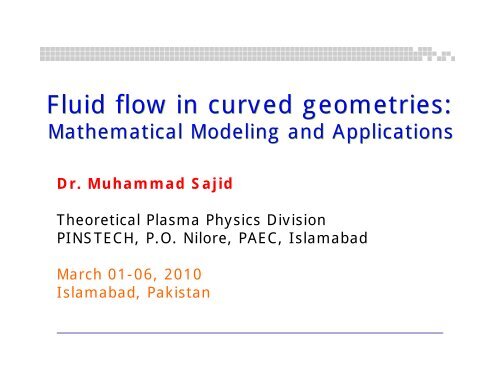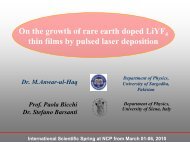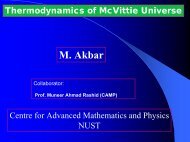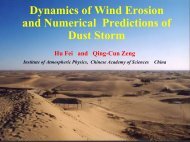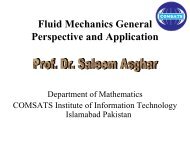Fluid flow in curved geometries
Fluid flow in curved geometries
Fluid flow in curved geometries
You also want an ePaper? Increase the reach of your titles
YUMPU automatically turns print PDFs into web optimized ePapers that Google loves.
Presentation LayoutAnalysis of fluid behaviourGovern<strong>in</strong>g equationsManifold and Metric∇ operationsStretch<strong>in</strong>g a <strong>curved</strong> surfacePeristaltic <strong>flow</strong> <strong>in</strong> a <strong>curved</strong> channelSummary
Analysis of fluid behaviour Analysis of any problem <strong>in</strong> fluid mechanicsnecessarily <strong>in</strong>cludes statement of the basic lawsgovern<strong>in</strong>g the fluid motion. The basic laws, whichapplicable to any fluid, are:Conservation of massNewton’s second law of motionThe pr<strong>in</strong>ciple of angular momentumThe first law of thermodynamicsThe second law of thermodynamics
Analysis of fluid behaviour NOT all basic laws are required to solve any oneproblem. On the other hand, <strong>in</strong> many problems itis necessary to br<strong>in</strong>g <strong>in</strong>to the analysis additionalrelations that describe the behavior of physicalproperties of fluids under given conditions. Many apparently simple problems <strong>in</strong> fluidmechanics that cannot be solved analytically.In such cases we must resort to morecomplicated numerical solutions and/orresults of experimental tests.
Manifold and metricWhat is a manifold?A manifold is a geometric ‘th<strong>in</strong>g’ which hasopen charts, subsets where a flat set ofcoord<strong>in</strong>ates is given. In general, however,they can be built by patch<strong>in</strong>g together on atlasof open charts.We need to review open charts
Open charts:Manifold and metricThe same po<strong>in</strong>t is conta<strong>in</strong>ed <strong>in</strong> more than one openchart. Its description <strong>in</strong> both charts is related by acoord<strong>in</strong>ate transformation
Manifold and metricDifferentiable structure
Manifold and metricDifferentiable structure
ManifoldManifold and metricParallel transportA vector field is parallel transported along a curve,when it manta<strong>in</strong>s a constant angle with the tangentvector to the curve
Manifold and metricThe metric: a rule to calculate the lenghtof curves!!Connection and covariant derivativeA connection is a map∇:TM× TM→TMFrom the product of thetangent bundle with itself tothe tangent bundle
In a basis...Covariant derivativeThis def<strong>in</strong>es the covariant derivative of a (controvariant) vector field<strong>Fluid</strong> Mechanics Group (FMG)14
Covariant derivativeCovariant derivative of a general tensorVector (first order tensor, r + s = 1)ii ∂Ai n ∂AiA, m= + ΓnmA ; Ami ,m= − Γm∂ξ∂ξ• Second-order tensor (r + s = 2)nimAnijij ∂Ti nj jT,m= + ΓnmT+ Γ Tmnm∂ξ∂TijnnTij,m= − ΓimTnj− ΓjmTm<strong>in</strong>∂ξii∂T•j i n nT• j ,m= + ΓnmTj jmTm•− Γ∂ξ<strong>in</strong>i• netc.r = 2, s = 0r = 0, s = 2r = 1, s = 1
For the velocity field∇ operationsV =i jV ( u )Gradient of the velocity field iseiLiik= ∇V= V ; j = g gjmm,[( )]mmm llg V k + Γ g VlklDivergence of the velocity field isi∇ ⋅ V = V ; i = ,( )iii mmg Vii + Γmig VmWhere ; represent the covariant derivative
Divergence of a tensor∇ ⋅ T =( ) [( )]kk ii jji mm jj j ii mmV⋅ ∇ T = g g g V g g T , k + Γ g g T + Γ g g Tiijjgiik( )ii jjg g T⎡⎢⎢⎣+ Γjmj(V⋅∇) of a vectorijgiiijg,jmmmk+ ΓTim( )( )ii kk∇ V = g g V g VV⋅ ,kk(V⋅∇) of a tensor∇ operationsiimjgmmmjgjjmkTmj[ ]k mmi + Γ g Vkmi⎤⎥⎥⎦mim
Stretch<strong>in</strong>g a <strong>curved</strong> surfaceGeometry of the problemFig. 1 (a)Fig. 1 (b)r, vs, uRO(a) a flat stretch<strong>in</strong>g sheet, (b) a <strong>curved</strong> stretch<strong>in</strong>g sheet.
Stretch<strong>in</strong>g a <strong>curved</strong> surfaceMathematical FormulationCurvil<strong>in</strong>ear coord<strong>in</strong>ates ( r + R,s)metriccont<strong>in</strong>uity equationg ab⎛1⎜⎝0=2∂∂r0⎞( r + R) ⎟⎠∂u∂s{( r + R)v} + R = 0,components of equation of motion2u 1 ∂p=r + R ρ ∂r,v∂u∂r+Rur + R∂u∂s+uvr + R1= −ρ rR+ R∂p∂s⎛+ ν⎜⎝2∂ u2∂r+r1+ R∂u∂r−( ru+ R)2⎞⎟,⎠
Stretch<strong>in</strong>g a <strong>curved</strong> surfaceThe boundary conditions applicable to the present<strong>flow</strong> areuas,u → 0,∂u∂rUs<strong>in</strong>g the similarity transformationu = asf ′The problem takes the form=Rr + Rv=0atr=0,→ 0 as r → ∞.2 2( η ),v = − aνf ( η) , p = ρas P(η),η = r.2kf ′′P = f ′′′ + −η + k η + kf ′( η + k)kη + k2∂Pf ′=∂ηη + kkη + kk( η + k)′ 2− f + ff + ff2 2′′aν′,ff =′ →0,0,ff′ = 1 at η = 0,′′ → 0 as η → ∞,
Stretch<strong>in</strong>g a <strong>curved</strong> surfaceElim<strong>in</strong>at<strong>in</strong>g pressuref iv2 f ′′′+η + k−f ′′ f ′ kk ′ 2k+ − ( f f′′′ − ff ′′′ ) − ( f − ff ′′)− ff ′ = 0.2 323( η + k)( η + k)η + k( η + k)( η + k)The sk<strong>in</strong> friction coefficientf ′(0)1Re 1 / 2xC f= f ′′(0)+ = f ′′(0)k+ kIt is important to po<strong>in</strong>t out that the Crane’sproblems can be recovered by tak<strong>in</strong>g k → ∞ . Thenumerical solution of the problem is developed by ashoot<strong>in</strong>g method us<strong>in</strong>g a Runge-Kutta algorithm.
Stretch<strong>in</strong>g a <strong>curved</strong> surface1.00.81.21.0k = 1000 ; k = 20 ; k = 10 ; k = 50.60.8f 'HhL0.4k = 1000 ; k = 20 ; k = 10 ; k = 5f HhL0.60.40.20.20.00 1 2 3 4 5 6h0.00 1 2 3 4 5 6hr-component of velocity, s-component of velocity
Stretch<strong>in</strong>g a <strong>curved</strong> surfacePHhL0.020.00-0.02-0.04-0.06-0.08-0.10k = 1000 ; k = 20 ; k = 10 ; k = 50 1 2 3 4 5 6Dimensionless pressurehk1/2−C f Re x5 0.7576310 0.8734920 0.9356130 0.9568640 0.9675950 0.97405100 0.98704200 0.993561000 0.99880Sk<strong>in</strong> friction coefficient
Peristaltic <strong>flow</strong> <strong>in</strong> a <strong>curved</strong> channelGeometry of the problem⎡2π( ) = + ( − )⎤H X, t a bs<strong>in</strong> ⎢ X ct , Upper wall⎣ λ ⎥⎦⎡2π( ) ( )⎤− H X, t =−a−bs<strong>in</strong> ⎢ X −ct. Lower wall⎣ λ ⎥⎦
Peristaltic <strong>flow</strong> <strong>in</strong> a <strong>curved</strong> channelMathematical FormulationGovern<strong>in</strong>g equations <strong>in</strong> fixed frame:∂∂R{( ) }R R V R∂U+ * + * =∂X*2V V R U V U p 1V+ V + − =− + R + R* * *∂ ∂ ∂ ∂ *ν ⎡ ∂ ⎧ ∂ ⎫⎢ ⎨( ) ⎬∂t ∂ R R + R ∂ X R + R ∂ R ⎢⎣R + R ∂R⎩ ∂R⎭*22 *⎤⎛ R ⎞ ∂ V V 2R ∂U+ ⎥⎜ ,* ⎟ − +2 2 2R R * *⎝ + ⎠ ∂ X ( R R) ( R R)∂X⎥+ + ⎥⎦* *∂U ∂U R U ∂U UV R ∂p 1* UV ν ⎡ ∂ ⎧ ∂ ⎫+ + − =− +* * *⎢* ⎨( R+R ) ⎬∂t ∂ R R+ R ∂ X R+ R R+ R ∂ X ⎢⎣R+ R ∂R⎩ ∂R⎭*22 *⎤⎛ R ⎞ ∂ U U 2R ∂V+ ⎥⎜ .* ⎟ − +2 2 2R R * *⎝ + ⎠ ∂ X ( R R ) ( R R )∂X⎥+ + ⎥⎦0,
Peristaltic <strong>flow</strong> <strong>in</strong> a <strong>curved</strong> channelGovern<strong>in</strong>g equations <strong>in</strong> wave frame:∂∂r{( ) }r R v R( ) ( )*R u c u c∂u+ * + * =2∂v ∂v + ∂v + ∂p ⎡ 1 ∂ ⎧* ∂v⎫− c + v + − =− + ν* *⎢* ⎨( R + r)⎬∂x ∂ r R + r ∂ x R + r ∂ r ⎢⎣R + r ∂r ⎩ ∂r⎭*22 *⎤⎛ R ⎞ ∂ v v 2R ∂u+ ⎥⎜ ,* ⎟ − +2 2 2R r * *⎝ + ⎠ ∂ x ( R r) ( R r)∂x⎥+ + ⎥⎦( ) ( )**∂u ∂u R u+ c ∂u u+ c v R ∂p ⎡ 1 ∂ ⎧* ∂u⎫− c + v + − =− + ν* * *⎢* ⎨( r+R ) ⎬∂x ∂ R R+ R ∂ x R+ R R+ R ∂ x ⎢⎣r+ R ∂r ⎩ ∂r⎭*22 *⎤⎛ R ⎞ ∂ u u 2R ∂v+ ⎥⎜ .* ⎟ − +2 2 2v R * *⎝ + ⎠ ∂ x ( r R ) ( r R )∂x⎥+ + ⎥⎦∂x0,
Peristaltic <strong>flow</strong> <strong>in</strong> a <strong>curved</strong> channelNon-dimensional variables:2πx r u v ρcax= , η = , u = , v= , Re = ,λ a c c µ2 *2πa H RP = p, h= , k = ,λµ c a aStream function: ∂ψk ∂ψ2u =− , v=δ where δ =∂ η η+ k ∂xUnder the long wavelength approximation we have∂ P = 0,∂η2∂P1 ∂ ⎧ ∂ψ⎫ 1 ⎛ ∂ψ⎞− − ⎨( η + k )1 0.2 ⎬− ⎜ − ⎟=∂x k ∂η ⎩ ∂ η ⎭ k( η+ k)⎝ ∂η⎠π a.λ
Peristaltic <strong>flow</strong> <strong>in</strong> a <strong>curved</strong> channelElim<strong>in</strong>at<strong>in</strong>g pressure⎧ ⎫ ⎧ ⎛ ⎞⎪⎫⎨ + ⎬+ ⎨ 1− ⎟⎬=0.∂ ⎩ ∂ ⎭ ∂ ⎪⎩( + k)⎝ ∂ ⎠⎪⎭2 21 ∂ ∂ ψ ∂ ⎪ 1 ∂ψ2( η k )2⎜k η η η η ηq ∂ψψ =− , = 1 at η = h= 1+φs<strong>in</strong> x,2 ∂ηq ∂ψψ = , = 1 at η =− h=−1−φs<strong>in</strong> x,2 ∂ηSolution of the problemC( ) ( ( ) ) ( ) 2 ( ) 2C ⎧1 ⎪η+ k ⎫⎪η+kψ = η+ k + ⎨ ln η+ k − 1 ⎬+ C + C ln ( η+ k)+ C2 ⎪⎩2 ⎪⎭42 3 4C ⎡η+ k η+k C3⎤u = + ( η k) { ( η k)} C22⎢ + + + − + +2 2 η + k⎥⎣⎦11 ln 1 .( )− 8hk 2h + q=− 4hk + h −k ln k− h + ln k+ h −2 h −k ln k− h ln k+h2 2( ) ( ) ( ) ( )( ) ( ) ( )1 2 2 2 2 2 2 22
Peristaltic <strong>flow</strong> <strong>in</strong> a <strong>curved</strong> channeldp=CC( )2 2( ) ( ) ( ) ( )2 2( h q) hk ( k h) ( k h) ( k h) ( k h)− 2 2 + 2 + − ln − − + ln +=− 4h k + ( h −k ) ln( k− h) + ln( k+ h)−2 h −k ln k− h ln k+h2 22 ⎛k−h⎞( h − k ) ( 2h+ q)ln⎜ ⎟k+h=⎝ ⎠2 2 2 2 2 22 2− 4h k + h −k ln k− h + ln k+ h −2 h −k ln k− h ln k+h22 2 2 222 22( ) ( ) ( ) ( )( ) ( ) ( )3 2 2 2 2 2hk ( h hk h q k q) ( h k )3 2 22 ⎛k−h⎞2 2 − 2 + + + − ln⎜⎟×⎝k+h⎠( −2h− q+ ( 2( h+ k)+ q) ln ( k− h) + ( 2h− 2k+ q) ln ( k+h))C4 =−2 2 2 22 2 22 222( − 4h k + ( h −k ) ( ln ( k− h) + ln ( k+ h)) −2( h −k ) ln ( k− h) ln ( k+h))The axial pressure gradient turned out to be( + )8h 2h q2 2( ) ( ) ( ) ( )( ) ( ) ( )dx 2 2 2 222 224 h k h k ln k h ln k h 2 h k ln k h ln k h− + − − + + − − − +The dimensionless pressure rise over onewavelength is def<strong>in</strong>ed by 2∆ Pλπ= ∫0dpdxdx.
Peristaltic <strong>flow</strong> <strong>in</strong> a <strong>curved</strong> channel
Peristaltic <strong>flow</strong> <strong>in</strong> a <strong>curved</strong> channelk = 3.5k = 5k =10k →∞
Summary The ∇ operations for curvil<strong>in</strong>earcoord<strong>in</strong>ates have been discussed. Flow of a viscous fluid due toStretch<strong>in</strong>g a <strong>curved</strong> surface isanalyzed.Peristaltic <strong>flow</strong> <strong>in</strong> a <strong>curved</strong> channel is<strong>in</strong>vestigated.
Thank You!


